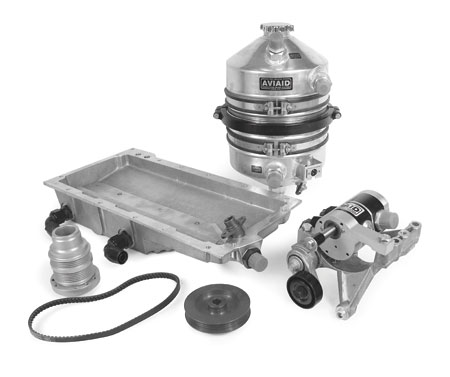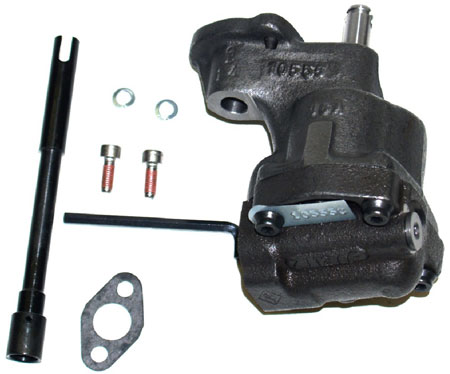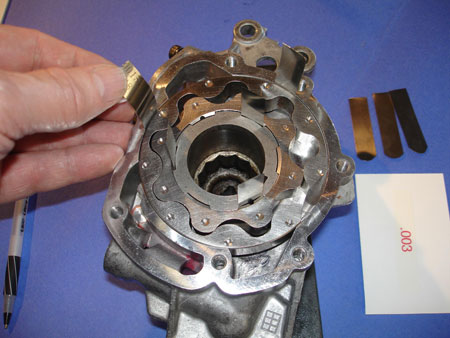For the engine to survive, the oiling system must be capable of supplying an adequate volume of oil under a wide range of operating conditions. The oiling system must also maintain adequate pressure to keep the oil flowing to all of the places where it is needed. Critical among them are the crankshaft and camshaft bearings, the lifters and upper valvetrain.
The key to any performance oiling system is the oil pump. Whether it is a crankcase-mounted pump driven by the distributor or cam or a front-mounted pump driven by the crankshaft, the job is the same: to pull oil from the oil pan and push it through the oil filter and passages that lubricate the engine. A wet sump pump should never suck air and should not starve for oil when the vehicle or race car is accelerating, braking or cornering hard. The best performance oil pump that money can buy is worthless if it can’t keep the engine lubed because it has been mismatched with a poorly designed or inadequate oil pan or pickup.
Performance Oil Pumps
The old rule of thumb that an oil pump should be capable of maintaining a minimum of 10 psi at idle, and build an additional 10 psi for every 1,000 rpm increase in engine speed does not always apply, depending on what you are trying to accomplish. Most NASCAR engines run half the normal oil pressure to reduce parasitic horsepower losses created by the oil pump.
They are able to reduce oil pressure by building their engines with very tight bearing clearances and using extremely low viscosity 0W-20 synthetic racing oils. Consequently, the type of oil pump you choose to put into a performance engine will depend on the engine’s internal bearing clearances (tight or loose), oil viscosity (thick or thin), how much oil you need to route to the upper valvetrain and the engine’s peak operating rpm.
For a typical performance engine with .002? to .0025? of main and rod bearing clearance and 20W-50 oil, an oil pump that flows the same or slightly better than a stock pump should be adequate. If you’re on the looser end of the bearing clearances (say .003? or more), or you need extra oil flow to the upper valvetrain area or to an external oil cooler, then you’d probably want a higher volume pump (say 10 to 30 percent more flow depending on the engine’s requirements).
One thing to keep in mind about heavy viscosity oils is that heavier oils place more stress on the oil pump and increase the power consumed by the pump. This can also increase the risk of the housing cracking or breaking.
Some aftermarket oil pumps have been redesigned to improve the strength of the housing and/or made with stronger components (such as billet steel gears, chrome moly shafts or even billet steel housings) to handle more demanding applications.
Something else to keep in mind is that the output flow of many stock pumps flat lines above 5,000 rpm due to cavitation inside the pump and/or restrictions created by the oil pump pickup tube and inlet screen.
According to Mike Osterhaus and Paul Hauglie of Melling Engine Parts, gerotor and spur gear oil pumps both use about the same horsepower to pump oil, but gerotor pumps typically experience less cavitation at higher rpms and may be better suited for some high revving engines (for additional information about oil flow and oil pressure, see page 12 of this issue).
What about rebuilding or modifying a stock oil pump? Rebuilding a stock oil pump would probably be okay for a mild street performance engine provided the pump housing and gears are not worn. Internal clearances between the gear teeth and the gears, housing and cover should not exceed .004? to .005? depending on the pump.
The greater clearances inside the pump, the less efficiently it will move oil and build pressure. The gears, housing and cover plate on most high mileage oil pumps are usually worn because the pump runs on unfiltered oil.
Replacing or resurfacing the pump end cover or face plate to make it flat or can reduce end clearances between the gears and cover, but it won’t do anything to restore play between the gears or between the gears and housing. Better to replace the pump with a brand new one that has minimal internal clearances (but not so tight that it risks binding or galling!).
Blueprinting a stock pump by porting, rounding and carefully blending the oil inlet and outlet ports can improve flow somewhat. The best gains, however, are realized by replacing the stock pump with a performance pump that has better designed inlets and outlets, and/or a physically larger housing with taller gears that can move more oil.
One of the biggest mistakes to avoid is putting too big of an oil pump on an engine and having oil pressure problems because of excess oil pump bypass flow. Like anything on an engine, the part must be efficient and correct for the application.
In many cases, a standard volume oil pump is good enough for moderate power engines. Oil pressure may appear low at times, but like your heart and blood, as long as something is flowing the engine will stay alive. Oil pressure is important when the engine is under a load, but idling in park or in gear doesn’t require 60 psi. Some engine builders run standard volume big block Chevy oil pumps on 1,200 horsepower engines with no problems whatsoever.
Oil Pans
It’s also beneficial to replace the stock oil pan with one that has increased oil capacity. More quarts of oil in the pan helps the oil run cooler and also reduces the risk of the pump pulling oil out of the pan faster than it can drain back into the pan from the cam valley and cylinder heads. If heat is a major concern, depending on the racing application, adding an external oil cooler can help keep oil temperatures within safe limits.
A performance oil pan should also have improved baffling to minimize oil slosh and the risk of oil starvation when accelerating, braking and cornering, and some type of windage control to minimize oil aeration when the crankshaft is spinning at high rpm. Aftermarket oil pan suppliers have pans that are designed for specific types of applications ranging from street to circle track, drag race, road race and off-road.
These are purpose-built products optimized for the type of racing conditions the engine is likely to experience. If you’re not sure what type of oil pan might be best for a customer’s engine, ask the oil pan suppliers for their recommendations.
According to Thor Schroeder of Moroso Performance Products, most oil pan decisions are typically based on two things: Chassis clearance and engine rpm. Chassis clearance will determine what depth the front sump can be. In many cases this will determine if a full race pan or stock core based oil pan can be used. It is common to have engines with long strokes that don’t leave much room for an oil pan, so the pan has to accommodate both the engine and the application.
Engine speed will affect an oil pan’s kick-out requirements, and what type of internal windage configuration will be needed. Maximum rpm is one thing, but what is the common rpm, or peak shift rpm? Shift rpm is a factor because the engine will see that rpm a few times during a run or a lap.
Schroeder also says that oil pan capacity depends on how much oil is flowing through the engine and how efficient the oil return ability of the cylinder heads and block are. “We see many times where a race engine that doesn’t have an oil restrictor will require more oil because the oil gets to the top of the engine faster than it can return to the oil pan. An engine that would be an 8 quart engine may need 9.5 quarts just to maintain oil pressure during a run. Oil coolers and accumulators will also determine oil capacity and remote oil filters.”
Ken Sink of Milodon says one of the most common problems he sees is mismatched oil pump and oil pan combination. “Some engine builders will buy an oil pump and pickup from one supplier and an oil pan from another assuming they will work together just fine. But if the pickup isn’t positioned 1/4 to 3/8 of an inch above the bottom of the oil pan, the oil can cavitate and allow air to be sucked into the pump causing oil pressure to fluctuate.
“A worse situation would be the pickup placed too close to the bottom of the pan. If there’s not enough clearance, the pickup might be restricted and starve the engine for oil. Engine builders should always measure the height of the pickup and compare it to the depth of the pan before the pan goes on, or use modeling clay in the bottom of the pan to make sure you will have proper clearances when you install the pan.”
Sink said his oil pump pickups have a small foot that protrudes from the bottom of the pickup inlet. The foot sticks out far enough to prevent oil starvation if the pan is too close to the pickup. “I’ve seen circle track racers who have dented in the bottom of their oil pan during a race, but didn’t starve their engine for oil because that little foot saved them.”
Chevy LS Oil Pump Problems
Like many other newer engines, the oil pump on Chevy LS engines is front mounted in an aluminum housing and is driven by the crankshaft mounted gear. One of the advantages of this type of pump design is that the pump turns at crankshaft speed, rather than half speed as is the case with distributor and cam driven oil pumps.
Consequently, a front mounted pump has the capacity to deliver more oil flow at lower engine speeds, which is why this style of pump is used in many overhead cam engines as well as the Chevy LS pushrod engines.
The aluminum housing on the Chevy LS pumps as well as those on Ford and Chrysler applications is rather fragile and can be easily distorted if the pump housing is clamped in a bench vise while working on it. Distort the pump housing more than a few thousandths and you’ll ruin it.
Schumann Sales & Service has recently introduced a new holding fixture for the Chevy LS pump that allows the pump to be safely mounted and supported while being held by a vise. The fixture has four mounting studs that are precision ground to equal height to support the pump. The fixture can then be clamped in a bench vise while the pump is being worked on. Similar fixtures are also available for Ford and Chrysler front mounted pumps.
The biggest problem engine builders are encountering with Chevy LS pumps, however, is pump failures caused by not getting the pump correctly centered on the crankshaft when the pump is installed on the engine. You can’t just slap it on the front of the block and bolt it up. Clearances are critical, and if you’re off more than a few thousandths of an inch the pump may bind and fail when the engine is first started.
One way to line up the pump is to set the engine block up on end so the crank is vertical rather than horizontal, then position the pump on the block while a helper slowly rotates the crank. The idea is to center the pump as best you can so that the gears don’t rub or bind against the housing or each other. It’s a cumbersome way to install an oil pump and there’s no guarantee that it will be correctly aligned.
Verne Schumann’s solution to the problem is a Chevy LS oil pump installation shim kit. The kit includes three sets of shims for centering the outer gear in the pump housing and the inner gear to the crank. Three shims are evenly spaced between the outer gear and pump housing, and three shims are evenly spaced between the inner gear and crank. Once the proper clearances have been set, the four mounting bolts that attach the pump to the block can be tightened down.
Schumann says the Chevy LS oil pump clearances should always be measured, and if you find more than .004? of play the pump is worn and should be replaced.
The stock Chevy LS pump is capable of pumping more oil than the stock pickup inlet tube may be able to supply. The inlet tube attaches to the pump with an O-ring fitting, which creates a slight restriction where the tube enters the pump housing.
On Schumann’s Pro Max Series X-tra oil pumps, this area in the pump housing is machined out to eliminate the O-ring entirely. The end of the pickup tube is refitted with a flange style mount and gasket. This modification increases oil flow up to 30 percent over the stock pump configuration (which typically flows 4 to 6 gallons per minute).
On GM’s 5.3L LS engines, cold start up lifter noise can be a problem. For these applications, Melling has an improved flow M295 oil pump that delivers increased oil flow to remedy the problem.
Pickup Restrictions
Another potential problem area for performance engine oiling systems is the oil pump inlet tube. The small diameter of the tube and/or restrictions created by the screen, mesh or driller cover on the end of the tube may limit flow at higher engine speeds.
Stock inlet screens can be very restrictive depending on the diameter and spacing of the wire. A drilled inlet cover or coarse mesh cover usually flows much better, though the best flow results are usually obtained with a relatively open honeycomb style cover.
The heavier the viscosity of the oil, the larger the mesh or drilled openings in the inlet tube should be to maximize oil flow to the pump. Replacing the stock diameter pickup tube with a larger diameter tube also improves flow.
Careful attention needs to be paid to installation of the oil pump screen assemblies, says Melling’s experts. Position of the oil pump body and proper use of installation tools can ensure proper function. Just as with the fragile oil pump body, the pump screen itself shouldn’t be held in a vise – doing so can lock up the pump by crushing the gear pocket.
Pressure Losses
With crankcase mounted oil pumps, leaks may occur where the pump is bolted to the block or rear main cap. Most pumps are just a simple flush mount with no gasket. The mating surfaces on the pump and block usually have some roughness, so the joint typically leaks quite a bit of oil. That’s lost oil pressure and volume that should be going to the engine.
You can spend a lot of time carefully machining the pump mounting surfaces flat for a better fit, or you can install a special thin copper gasket that Schumann makes that fits between the pump and engine to seal the connection.
Late model crankshaft driven oil pumps have a tendency to leak due to the increased size of the rotor set relative to a cam driven pump. Melling says some of the updates that have made to their front cover oil pumps includes changes in materials and the use of coatings to improve performance and durability.
Hard coating improves the durability of the cast aluminum oil pump housing. The use of chrome-moly billet rotor sets in Melling’s Ford Modular oil pumps allows them to withstand the increased stresses found in high horsepower applications.
Priming The Engine
Priming the oil system prior to first starting the engine is a given. You don’t want to risk a dry start that would the camshaft and bearings so the oil system needs to be primed to get oil into the pump and oil passages.
With distributor driven pumps, this can be done by using a drill to spin the pump through the distributor opening. But with front-mounted crank driven pumps, this isn’t possible so oil must be fed into the oil system externally from a pressure oiler.















